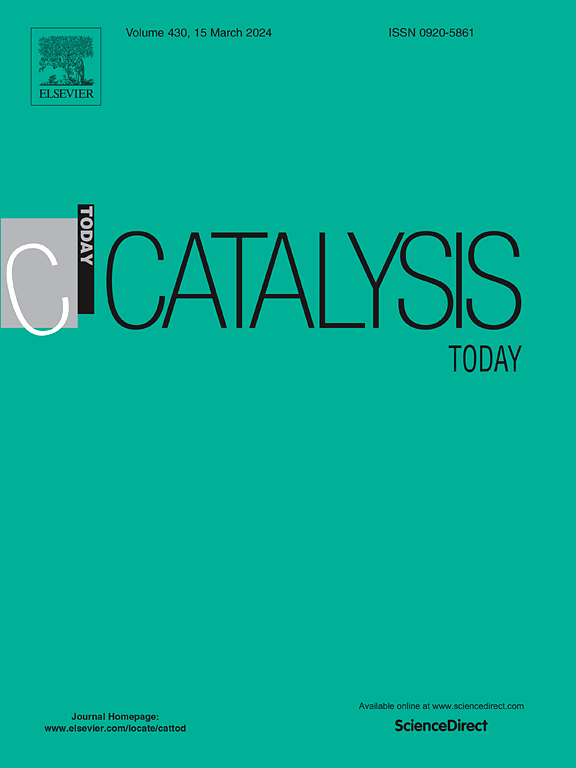Production of high value-added phenolic compounds through lignin catalytic pyrolysis over ion-exchanged hierarchical ZSM-5 and Beta zeolites
IF 5.2
2区 化学
Q1 CHEMISTRY, APPLIED
引用次数: 0
Abstract
Synthesised H-ZSM-5 and H-Beta zeolites with hierarchical porosity (h-H-ZSM-5 and h-H-Beta) have been ion-exchanged with alkali (Na+ and K+) and alkaline-earth (Mg2+) metals and have been evaluated as catalysts to produce high value-added products through catalytic pyrolysis of lignin. In comparison with the thermal test, hierarchical zeolites in acid form are effective catalysts for lignin pyrolysis, favouring the production of valuable light compounds although reducing bio-oil* yield and increasing gas and coke formation. In this way, h-H-ZSM-5 zeolite promotes the formation of oxygenated aromatics, being guaiacols and syringols the major products. Alkali-exchanged variants of this zeolite enhance demethylation reactions improving the selectivity towards 2-methoxy-phenol and syringol, by modifying acid site properties. On the other hand, h-H-Beta zeolite, with larger pore size and stronger acidity, leads to higher concentration of oxygenated aromatics for both parent and ion-exchanged catalysts. Specifically, h-KH-Beta promotes the production of 2-methoxy-phenol and syringol. Besides, h-MgH-Beta stands out for its greater selectivity towards phenol and alkylphenols, such as dimethylphenol. Overall, the combination of accessibility, provided by the hierarchical porosity, with the different nature and strength of the acid sites, induced by the ion-exchange with alkali and alkaline-earth metals, allows tailoring the lignin catalytic pyrolysis process to selectively produce high value-added compounds.
离子交换ZSM-5和β分子筛上木质素催化热解生产高附加值酚类化合物
合成的H-ZSM-5和h- β分子筛具有分级孔隙度(h-H-ZSM-5和h-H-Beta),与碱金属(Na+和K+)和碱土金属(Mg2+)进行离子交换,并被评价为木质素催化热解生产高附加值产品的催化剂。与热实验相比,酸形式的分级沸石是木质素热解的有效催化剂,虽然降低了生物油* 收率,增加了气体和焦炭的形成,但有利于产生有价值的轻质化合物。这样,h-H-ZSM-5沸石促进了含氧芳烃的形成,成为愈创木酚和丁香酚的主要产物。该分子筛的碱交换变体通过改变酸位性质增强了对2-甲氧基苯酚和丁香酚的去甲基化反应,提高了对2-甲氧基苯酚和丁香酚的选择性。另一方面,h- h- β分子筛的孔径更大,酸性更强,母分子筛和离子交换催化剂的氧化芳烃浓度更高。具体来说,h-KH-Beta促进2-甲氧基苯酚和丁香酚的生成。此外,h-MgH-Beta对苯酚和烷基酚(如二甲酚)具有更大的选择性。总体而言,由分层孔隙度提供的可及性,与碱和碱土金属离子交换引起的酸位点的不同性质和强度的结合,允许调整木质素催化热解过程,以选择性地生产高附加值化合物。
本文章由计算机程序翻译,如有差异,请以英文原文为准。
求助全文
约1分钟内获得全文
求助全文
来源期刊

Catalysis Today
化学-工程:化工
CiteScore
11.50
自引率
3.80%
发文量
573
审稿时长
2.9 months
期刊介绍:
Catalysis Today focuses on the rapid publication of original invited papers devoted to currently important topics in catalysis and related subjects. The journal only publishes special issues (Proposing a Catalysis Today Special Issue), each of which is supervised by Guest Editors who recruit individual papers and oversee the peer review process. Catalysis Today offers researchers in the field of catalysis in-depth overviews of topical issues.
Both fundamental and applied aspects of catalysis are covered. Subjects such as catalysis of immobilized organometallic and biocatalytic systems are welcome. Subjects related to catalysis such as experimental techniques, adsorption, process technology, synthesis, in situ characterization, computational, theoretical modeling, imaging and others are included if there is a clear relationship to catalysis.
 求助内容:
求助内容: 应助结果提醒方式:
应助结果提醒方式:


